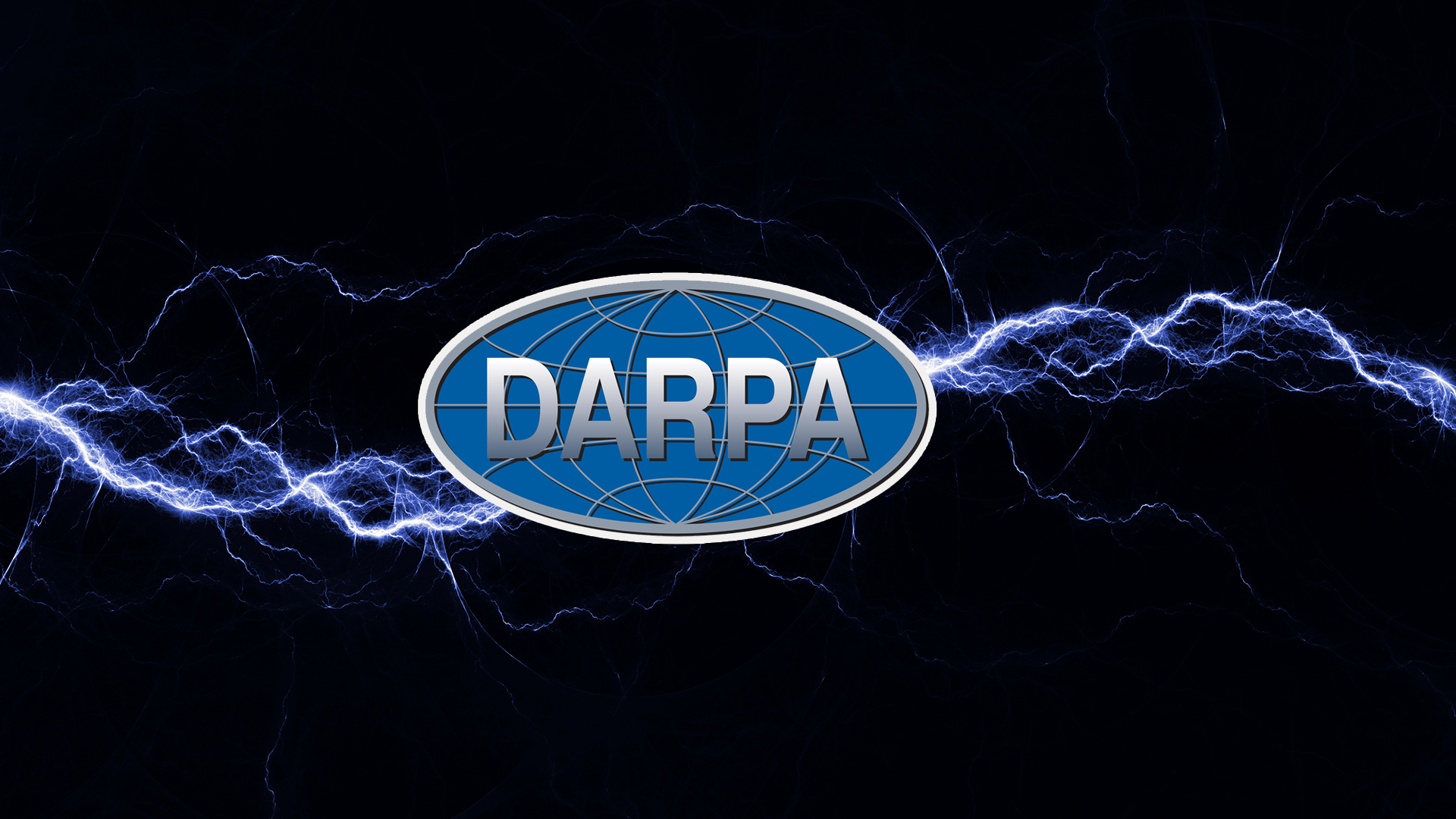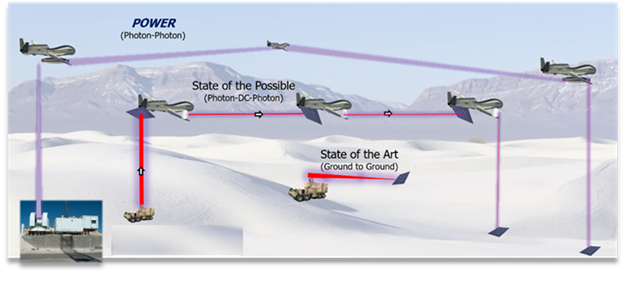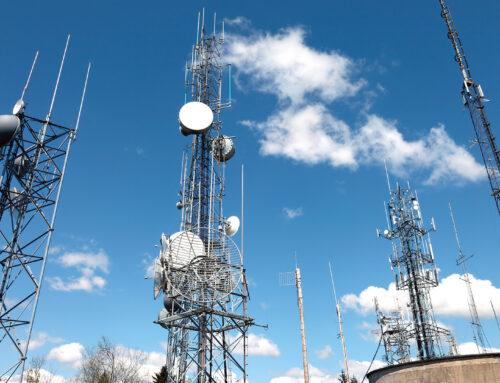
DARPA Developing a Revolutionary Airborne Wireless Power Distribution Network
The dream of transmitting electricity through the air has always been a fascination since we tamed the electron. Nikola Tesla imagined a world where we could send electricity through all mediums. Today, DARPA is pushing new boundaries by continuing the research and development of transmitting power wireless methods.
The Persistent Optical Wireless Energy Relay (POWER) program seeks to demonstrate the feasibility of a system that enables efficient transmission and reception of energy from ground-sourced lasers with airborne optical relays. This will allow for high-altitude, long-range delivery of energy at the speed of light, creating an adaptive and dynamic wireless energy web. The project is in the early development stage, with DARPA researching a broad range of technical challenges related to power beaming. These include the development of lightweight and efficient photovoltaic receivers, high-efficiency optical modulators, low-mass laser diodes, and airborne platforms able to modulate and relay energy over long distances.
With POWER, DARPA aims to revolutionize the way energy is delivered, boosting efficiency and providing a more reliable power grid. A successful demonstration of the program could have far-reaching implications on the world’s energy infrastructure.
The POWER program is developing technologies to enable energy transport over wireless networks, allowing military personnel to access electricity at unprecedented levels and with greater reliability. Through the use of radio frequency (RF) transmissions, it will be possible to transmit electrical power in a manner similar to how data is transmitted wirelessly. This technology has the potential to revolutionize not just the military, but also civilian applications. The technology would enable us to power remote and isolated areas with renewable energy sources and could even be used for disaster relief in areas where infrastructure has been damaged or destroyed.
POWER’s potential is not limited to providing electricity; it could also be used for miniaturizing medical technologies such as diagnostic tools or drug delivery systems. In addition, the technology could be used to power robots and drones, allowing them to operate in areas inaccessible to humans. The possibilities are virtually limitless! Ultimately, the POWER program has the potential to revolutionize how energy is accessed and distributed around the world. By harnessing wireless energy networks, we can create a more reliable and sustainable source of energy for not just the military, but also civilian applications.
Wireless power transfer networks generate power in one area and then transmit it wirelessly to another location, giving platforms access to a virtually unlimited supply of energy. This technology has the potential to revolutionize the way military operations are conducted, by reducing or eliminating the need for large fuel tanks on aircraft, ships, and other aerial or naval vehicles. With wireless power transfer networks, military platforms can be more agile and efficient, with shorter mission times and longer endurance capabilities. Additionally, this technology could also lead to advancements in other areas such as autonomous vehicle navigation systems and robotics.

Power Beaming Concept
Power Beaming
The concept of power beaming has been around since the early 1900s, but it was not until recently that advances in technology made it a feasible option. In addition to being used for wireless communication and charging devices, power beaming could also have applications in space exploration and transportation. For example, solar panels on spacecraft could use power beaming to beam energy to the ground, allowing them to stay in orbit for longer periods of time. It could also be used to provide power to aircraft, eliminating the need for fuel and reducing emissions. Power beaming can also be used as a form of transportation by sending electromagnetic waves through free space that move vehicles at high speeds without the use of traditional propulsion systems.
By harnessing the power of power beaming, we can open up a world of possibilities that could revolutionize the way we move and communicate. Its potential applications are vast and its future is bright. With further development, this technology may soon become an integral part of our lives.
Improving Power Conversion
An important part of improving network efficiencies is to reduce the number of conversions required. One way to do this is by using photonic materials in place of electricity, allowing the signal to be transmitted as a light wave rather than converted from one form to another. Photonic networks are able to transmit information over longer distances and with fewer losses, resulting in higher network efficiencies. In addition to being more efficient, photonic networks are also more secure because light waves cannot be intercepted like traditional electrical signals can. The use of photonic materials is becoming increasingly common as researchers continue to look for ways to reduce the energy consumption and improve the efficiency of communication networks. However, challenges still remain with the integration of photonic materials into existing networks and the development of new technologies to make use of them. It is clear that continued research in this area is necessary to fully realize the potential benefits of photonic networks.
POWER Program Roll Out
The first phase of the POWER program will focus on the development of an efficient power beaming relay architecture. This includes research into how to best design and construct the relays, as well as working to ensure they are able to effectively redirect optical energy transmissions while maximizing beam quality at each point along the way. The second phase will involve enhancing the efficiency of the system by selectively harvesting energy as needed. Finally, in the third and final phase of the program, a flight demonstration will be conducted to validate that the power beaming relay architecture is able to deliver desired results.
Through this ambitious project, scientists and engineers at DARPA will gain valuable insight into how best to design and construct an effective power beaming relay. This, in turn, could lead to the development of numerous new and exciting applications such as high-speed communications, targeted energy delivery and more.
New Power Era
The wireless energy web will enable a new era of mobility and operational flexibility, enabling military forces to move more quickly and efficiently. The concept is to have an entire energy distribution system that is untethered from traditional infrastructure such as fuel tanks and power lines. Instead, the energy would be wirelessly transmitted through beams or waves of electromagnetic radiation. This would significantly reduce the logistical burden of supplying energy, while also providing a more resilient and secure energy source.
Col. Paul Calhoun explained that, “The Wireless Energy Web will enable unprecedented levels of battlefield flexibility and situational awareness, allowing us to respond faster and in more dynamic ways than ever before. This could have far-reaching implications for military operations, from enabling faster reconfiguration of forces to more quickly establishing command and control networks.”
The military is already beginning to explore the possibilities of wireless energy transmission technology for use in its operations. For instance, the U.S. Navy has developed a wireless power transfer system (known as Electrified Shipboard Aircraft Launch System or ESALS) that is currently undergoing testing and is expected to be deployed in 2021.
In addition to its potential military applications, the wireless energy web could also have a big impact on civilian life. Calhoun explained that, “The same technology can be used for commercial purposes, such as providing electricity to remote areas or powering electric vehicles. We believe this technology can revolutionize the way we use energy and help create a more sustainable world.”
Ultimately, the wireless energy web could be a game-changer for military operations and civilian life alike, paving the way for a new era of mobility and operational flexibility. With advances in technology, it may soon become a reality.
Other RF News, Information & Resources
About Precision Millimeter Wave
We are a growing microwave & millimeter wave manufacturing & engineering company of parts, sub-assemblies and more for both passive & active based components.
Contact us for your needs.












